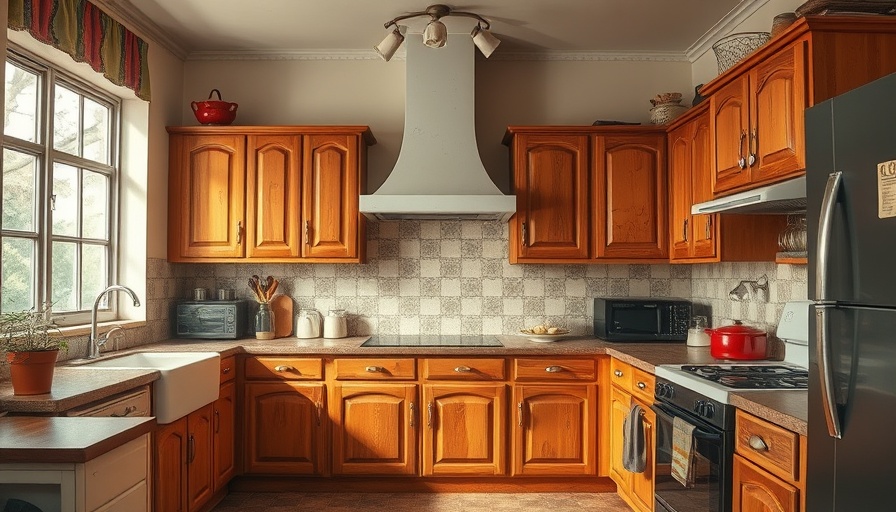
Keeping Vintage Charm: The Balance of Modern Design
As homeowners increasingly gravitate towards vintage aesthetics, the interior design landscape is seeing a blend of nostalgia and modernity. Many interior designers celebrate the revival of distinct styles from past decades, citing it as an opportunity to create spaces that tell stories and reflect personal heritage. However, this nostalgia does not extend to every retro trend. In fact, several so-called 'vintage' features are considered tired and outdated by design professionals, prompting a reassessment of which elements are worth resurrecting.
The Dangers of Overly Coordinated Sets
Many designers caution against the overuse of coordinated vintage furniture sets. Meghan Jay of Meghan Jay Design emphasizes that while a couple of vintage pieces can introduce character to a space, too many matching items can lead to a visually overwhelming environment. "A single vintage piece can anchor a room beautifully; however, when the furniture is overly matched, it quickly shifts from charming to heavy, diminishing the unique storytelling potential of each piece," she notes. By carefully curating only a few standout elements, homeowners can attain a more balanced aesthetic.
The Carpet Conundrum
Bathrooms often present a unique challenge in design, particularly regarding flooring. While the trend for vintage aesthetics leans towards cozy rugs, designers signal a red flag for carpet in this moisture-laden area. Lauren Saab of Saab Studios states, "Carpet in bathrooms should stay firmly in the past. It traps moisture and odors, while tile and stone offer the same softness underfoot when paired with a decorative rug without compromising hygiene." Choosing the right materials can help maintain a balance between aesthetics and practicality.
When Tile Turns Tacky
Tile countertops are often a point of contention among homeowners and professionals alike. As bold colors and unique patterns gain popularity, the notion of tiled countertops resurfaces. However, designers like Peggy Haddad advise caution. "While they can work in small spaces, tiled countertops can become a cleaning nightmare in kitchens and full baths. The grout lines simply don’t hold up well to everyday use," she warns. The modern preference leans towards materials like quartz or granite that combine beauty and functionality.
Ceiling Features: From Popcorn to Polished
Faux finishes such as popcorn ceilings are elements that designers unanimously agree should remain in the past. These textured ceilings, once a common style choice, have become synonymous with poor aesthetic and upkeep. Designers advocate for smooth, painted ceilings that improve the value and perception of a home. As Saab explains, "They trap dust and lower the perceived value of a home the moment you walk in. Smooth ceilings allow every design aspect to shine, elevating the overall ambiance of a room." In this case, going clean and polished benefits both the eye and the market value.
Stepping Back from Sponge Paint
The resurgence of vivid colors has led many to explore different painting techniques; however, sponge paint is often cited as the go-to faux finish that should be avoided. “If you want to play with texture, consider artisan wall treatments over sponge paint. Products like limewash or plaster provide a much more elevated look without falling into the dated habits of the past,” Haddad advises. Modern homes can achieve depth and character while steering clear of younger design trends that dilute the established vintage allure.
Future Trends: Vintage Elements with a Twist
It is clear that while vintage styles can offer warmth and personality to modern homes, not all elements hold up against contemporary design standards. As trends oscillate, designers emphasize the importance of discernment when selecting vintage features to repurpose. The movement towards a comfortable yet curated home reaches beyond merely mixing old and new; it compels homeowners to connect personally with their spaces, creating a tactile narrative that resonates with their lifestyle and values.
Final Thoughts: Embracing the Right Vintage
Choosing design elements for the home is as much about what to include as it is about what to avoid. Understanding which vintage trends are overdue for retirement helps homeowners curate spaces that are not only inviting but also timeless. As the design community continues to reevaluate these aesthetics, embracing select vintage features with care offers an opportunity for genuine expression devoid of pitfalls of cliché and excess.
 Add Row
Add Row  Add
Add 




Write A Comment